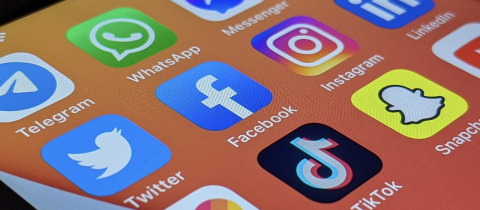It started with the Helen Keller jokes. You could call it an unfortunate revival. Over forty years ago and following the broadcast of The Miracle Worker, jokes about Helen Keller became mainstream. “What did Helen Keller’s parents do when they caught her swearing?” goes one of the milder wisecracks. “They washed her hands with soap!”
The story of Helen Keller, who was deafblind and rose to prominence as a fierce advocate for the rights of women, workers, and the disabled, inspired countless jokes when I was growing up. As the COVID-19 pandemic was just getting started, teenagers on TikTok rediscovered them and started acting them out on the video-sharing platform. But then, something else happened: TikTokers started “doing their own research.”
Reaching over half a million views, a video by user @MyGrandmasLooseLip compared the image of a blind eye with a photo of Helen Keller. Her own eyes looked functional, so why had she been lying about being blind?
Soon, a wave of videos crashed onto the platform, with users claiming—in the “kidding not kidding” way of Gen Z—that Helen Keller had never existed or that, at the very least, she had not been deafblind. After all, she wrote books. How can a deafblind person write books?
While some of these videos may have been made in jest, an explainer on deafblindness is probably needed.
And, yes, despite what my spellcheck tells me, it is “deafblindness” and not “deaf-blindness.”
Blind spots around deafblindness
There are many misconceptions around deafblindness, an umbrella of conditions that affect somewhere between 0.2 and 2% of the population worldwide. The first is that deafblindness, also known as dual sensory loss or dual sensory impairment, is a single entity. The TikToker comparing the eye of a person born blind to Helen Keller’s eyes was essentially committing this mistake. There are many ways of losing your sight and they will not present identically. The same goes for deafness. In kids alone, we know of over 70 different conditions that can lead to deafblindness, including rubella, meningitis, and genetic disorders.
The second myth is that dual sensory loss only or predominantly affects children. The truth is that the majority of people dealing with this condition are older adults. They used to be able to see and hear really well, but because of aging, they have lost a good deal of these two senses. The most common combination in older adults is age-related macular degeneration—in which the back of the eye loses part of its function, leading to a dark blob at the centre of one’s vision—and presbycusis, a hearing loss due to aging.
But yes, children can indeed develop deafblindness. The most frequent cause is Usher syndrome, which is a combination of inner ear or auditory nerve damage and an affliction of the back of the eye known as retinitis pigmentosa. The genetics of this syndrome are not simple: we know of 10 genes that can be associated with it.
The biggest mistaken belief, though, is that all people who are deafblind cannot see or hear anything. In fact, there are degrees of deafblindness, so much so that there is no universally accepted definition of this condition in the research literature. The so-called Nordic definition is often cited and I find it quite useful. It came out of the social and health sector of the governments of the Nordic countries in Europe. Deafblindness is here defined as a combined vision and hearing impairment of such severity that it is hard for the impaired senses to compensate for each other. It is thus a distinct disability, which is why it is typically written out as “deafblindness” without the hyphen: it is not a combination of being deaf and blind, but rather a third entity altogether.
A useful shorthand for deafblindness is that “1 + 1 = 3,” meaning that losing both your sight and your hearing results in a worse deprivation than simply summing them up. Deaf people, after all, can read texts and lips. Blind people can hear conversations. But how do deafblind people communicate?
Sign language is quite useful, but the way for deafblind people to see the signs is by placing their hands on top of the hands of the person signing. They may also sign in the palm of the hand. They can read books written in Braille. Children born with certain types of deafness can also gain some form of hearing through a cochlear implant, where microphones are directly hooked to the auditory nerve and their electrical signals can be interpreted by the brain as sounds. There is also an older form of lip reading called Tadoma, in which a deafblind person puts their hand on another person’s face, their fingers capturing the movements of the jaw, lips, and throat, to understand what is being said. And there is Protactile, a language that makes full use of the body and of sensations on the skin. Given what little research has been done, we still do not know exactly how the brain reorganizes itself when deprived of sight and sound, but it clearly can.
It may surprise you to learn that some people who developed deafblindness before they acquired a language can actually speak. Helen Keller was one of them, though not the first. It may sound like an impossibility, but when we read up on the story, we realize that with enough will power and support, human beings can accomplish a lot.
“I can speak, and perhaps I shall sing, too.”
Helen Keller’s teacher, Anne Sullivan, initially did not want her to try to speak. She thought that Keller’s inability to read other people’s lips would make it impossible for her to truly communicate using her voice, so she tried to repress Keller’s impulses to make sounds.
Keller was born in 1880 in Alabama, and she became deafblind following an illness when she was only a year and a half old. Her father asked for a teacher in the summer of 1886, but Anne Sullivan would only arrive in March of the following year. The difficulty in accessing support is something that even deafblind people today are all too accustomed to.
Keller’s language acquisition began with feeling an object with her hands while Sullivan would spell its name with her fingers as Keller held her hand. Keller would repeat the signs, quickly understanding that the two women were naming these objects with their fingers.
From there, Sullivan taught her sign-language names for actions, then full sentences. Keller learned the use of raised letters in printed books for the blind, and in July of that first year with her teacher she was already writing a perfect letter without assistance to one of her cousins. Through associations and repetitions, Helen Keller’s vocabulary grew and grew, but it was frustratingly limited to finger motions and writing.
What Keller wanted to do was speak and she convinced herself that she could feel her teacher’s mouth with her fingers well enough to understand how she was making sounds. Soon thereafter she learned the story of Ragnhild Kaata, a deafblind Norwegian girl who was taught to speak and did so by feeling her own teacher’s lips. There was no turning back.
Anne Sullivan started with individual sounds, like the “i” sound in “hit.” Keller would feel her teacher’s lips, teeth, tongue, and throat, and then move her fingers to her own face to mimic what Sullivan had done. She could not hear herself, of course, but Sullivan would tell her when she got it right, and Keller would repeat it again and again, committing the spatial arrangement of her features to memory.
The first word she sounded was “arm.” At Sullivan’s suggestion, this was immediately followed by “mamma” and “papa.” Vowels and consonants gave way to small words and to longer words. In an 1890 letter, Keller wrote, “I can speak, and perhaps I shall sing, too.”
She later became the first deafblind person to graduate from university. She gave lectures, wrote many books, and was one of the co-founders of the American Civil Liberties Union (ACLU). She was a profoundly political figure even though, through a process that has been called “heroification,” she, like so many inspirational figures, was turned into a pious, apolitical champion who simply overcame personal adversity in a society that accepted her with open arms. The reality is a lot more complicated. Earning her bachelor’s degree was not easy given the lack of availability of texts in Braille. Systemic barriers did slow her down. Earning a living was also challenging, which led her to join a vaudeville act she had turned down when she was younger. Helen Keller and Anne Sullivan played versions of themselves in front of audiences all over North America in a simplified dramatization of their real-life struggles.
Keller embraced pacificism, feminism, and socialism, famously stating that her success was owed in part to the advantages given to her by her birth and her environment. “I have learned,” she continued, “that power to rise is not within the reach of everyone.” Her so-called radical views earned her a continued surveillance by the FBI.
Nearly a century and a half after her birth, Helen Keller is now on the receiving end of a strange sort of denialism. The sentiment expressed in those TikTok videos is quite ableist and ignorant: that a person who cannot see or hear could never accomplish anything of substance. And given that its expression is done on a hip video platform, it is laced with irony poisoning, meaning that something starts out as a callous joke before slowly becoming a real belief which can easily be denied because it is expressed with irony. Kidding, not kidding.
Deafblind people are not dumber than those of us with full use of our eyes and ears. They can accomplish a lot with the right kind of support, though as the Croatian Deafblind group says with a wink, they just need three times more time. They can communicate in a variety of ways, can work and be independent. They often require access to rehabilitation services, which often go unmentioned, including low-vision rehabilitation, audiology, orientation and mobility, and computer accessibility.
Not everyone with deafblindness can be like Helen Keller, but Helen Keller would have been the first to admit it. And, yes, she really did exist.
Take-home message:
- Deafblindness is a combined loss, either partial or complete, of both hearing and sight where one sense cannot compensate for the loss of the other
- Although it does affect children, the majority of people with deafblindness are older adults whose sight and hearing degrade due to age
- While some teenagers seem to deny Helen Keller ever existed or really was deafblind, she was real and learned to speak by feeling what her teacher was doing with her mouth and tongue to pronounce sounds and words







